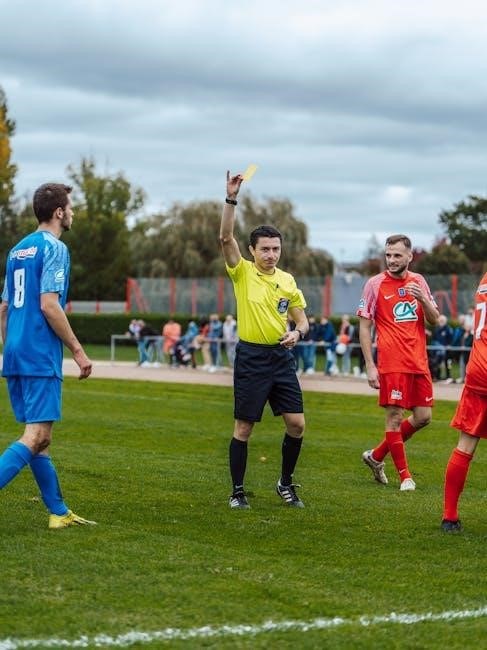Wavelength is a unique party game where players find consensus on spectrum-based prompts‚ sparking laughter and debates. It’s excellent for parties‚ team-building‚ or family gatherings‚ turning game nights into glimpses into each other’s minds.
1.1 Overview of Wavelength Game
The Wavelength game is a dynamic and engaging social deduction party game where players aim to align their thoughts on a spectrum-based scale. Two teams compete‚ rotating a dial to guess the position of a hidden target on a spectrum‚ guided by a single clue from a team member acting as the “Psychic.” This clue must relate to the spectrum‚ such as hot vs. cold or modern vs. antique‚ sparking lively debates and laughter. The game thrives on crafting clever questions that challenge players to think alike‚ making it ideal for parties‚ team-building‚ or casual gatherings. Its unique blend of strategy and humor allows players to glimpse into each other’s minds‚ fostering connection and entertainment. With its adaptable nature‚ Wavelength offers endless fun‚ whether you’re exploring pop culture‚ history‚ or thought-provoking topics.
1.2 Importance of Questions in Wavelength
Questions are the heart of the Wavelength game‚ driving its engaging and dynamic gameplay. They are designed to spark debate‚ encourage creative thinking‚ and reveal players’ personalities. Well-crafted questions ensure the game remains entertaining and thought-provoking‚ whether they are easy‚ medium‚ or challenging. The variety of topics‚ from pop culture to history‚ keeps players engaged and fosters meaningful conversations. Questions also serve as tools for team bonding‚ as players must align their thoughts to succeed. Their relevance and originality are key to maintaining player interest and ensuring the game stays fresh. With countless options available online‚ including PDF resources‚ players can endlessly expand their question pool‚ making Wavelength a versatile and enduring party favorite. The right questions create a balance of humor and depth‚ making the game a memorable experience for everyone involved.

Types of Wavelength Questions
Wavelength questions vary in difficulty‚ ranging from easy‚ quick-fire choices to medium‚ thought-provoking dilemmas‚ and challenging‚ deep topics like justice vs. mercy. These categories ensure dynamic gameplay and cater to all player preferences‚ keeping the game engaging and fun.
2.1 Easy Wavelength Questions
Easy Wavelength questions are perfect for warming up the group and getting players comfortable with the game. These questions are quick‚ lighthearted‚ and general enough for anyone to understand. Examples include “Whimsical vs. stoic‚” “Dogs vs. cats‚” or “Loud vs. quiet.” They are designed to be simple yet engaging‚ allowing players to ease into the game without feeling overwhelmed.
These questions often focus on everyday topics or clear contrasts‚ making them accessible to all players. For instance‚ “Sweet vs. spicy” or “Morning lark vs. night owl” are easy to grasp and spark initial laughter and debates. The goal is to create a relaxed environment where everyone can participate and enjoy the game.
Easy questions are a great way to break the ice and set the tone for more challenging rounds. They ensure that even new players can jump in and have fun without feeling confused or left out.
2.2 Medium Difficulty Questions
Medium difficulty Wavelength questions are designed to challenge players while still maintaining a level of accessibility. These questions are slightly more nuanced than the easy ones‚ requiring a bit more thought and discussion. Examples include “How predictable is a mystery novel?” or “How much does social media affect our lives?” These prompts encourage players to think critically about common topics but with a deeper layer of analysis.
Such questions are ideal for keeping the game engaging without overwhelming the players. They often touch on relatable themes like technology‚ culture‚ or everyday experiences‚ making them relevant to a wide audience. For instance‚ “Fast food vs. vegan cuisine” or “Netflix chill vs. ghosting” spark interesting debates that are both fun and thought-provoking.
Medium difficulty questions strike a balance between simplicity and complexity‚ ensuring that the game remains dynamic and enjoyable for all participants. They are perfect for transitioning from easy to challenging questions‚ keeping the gameplay fresh and exciting.
2.3 Challenging Wavelength Questions
Challenging Wavelength questions push players to think deeply about complex topics‚ fostering meaningful conversations and debates. These questions often revolve around abstract concepts or moral dilemmas‚ such as “Justice vs. mercy” or “Technology vs. nature.” Players must consider their beliefs and how they align with others‚ making these prompts ideal for sparking intense discussions.
Examples include “Fame vs. fortune” or “Eternal life vs. mortality‚” which require players to weigh opposing ideas carefully. These questions are designed to test how well participants can align their thoughts‚ encouraging creative and critical thinking.
Challenging questions add depth to the game‚ making it more engaging for experienced players. They ensure that the gameplay remains stimulating and thought-provoking‚ keeping everyone invested in the outcome.

Categories for Wavelength Questions

Wavelength questions are organized into diverse categories‚ such as pop culture‚ food‚ history‚ music‚ movies‚ and funny or quirky themes. These categories ensure a wide range of topics‚ keeping the game engaging and inclusive for all players.
3.1 Pop Culture Questions
Pop culture questions are a vibrant category in Wavelength‚ covering music‚ movies‚ TV shows‚ celebrities‚ and memes. Players debate spectrum-based prompts like Drake vs. Kendrick or Tupac vs. Biggie‚ sparking lively discussions. Movie-themed questions‚ such as Titanic vs. The Notebook‚ encourage creative thinking. These questions are designed to reveal shared tastes and preferences‚ making them ideal for engaging a wide range of players. Fun meme categories‚ like Grumpy Cat vs. Doge‚ add humor and appeal to younger audiences. By incorporating familiar pop culture references‚ these questions ensure the game remains dynamic and relatable‚ fostering debates that reflect current trends and timeless classics alike. This category is perfect for groups who enjoy discussing modern icons and nostalgic favorites‚ offering endless opportunities for playful and insightful conversations.
3.2 Food and Drink Questions
Food and drink questions bring a delicious twist to Wavelength‚ offering a flavorful way to engage players. These prompts range from broad comparisons like pizza vs. tacos to more specific ones like deep dish vs. thin crust. Players debate whether fast food is better than vegan cuisine or if Italian dishes outrank Mexican ones. Questions like keto vs. vegetarian or Gordon Ramsay vs. Guy Fieri add a fun‚ personal touch. For foodies‚ categories like medium vs. medium-rare or dive bar vs. fancy cocktail joint spark lively discussions. These questions are designed to cater to diverse tastes‚ making them accessible to everyone. Whether you’re comparing comfort foods or debating culinary preferences‚ food and drink questions ensure the game stays fresh and engaging. They’re perfect for groups who enjoy sharing opinions on their favorite eats and treats.
3.3 History-Themed Questions
History-themed questions in Wavelength add a fascinating layer of nostalgia and educational fun to the game. These prompts allow players to dive into the past‚ comparing iconic events‚ eras‚ or cultural movements. For example‚ questions like “Summer of Love vs. Salem Witch Trials” or “First Flight vs. the Hindenburg Disaster” spark engaging debates. Players might debate whether the French Revolution was more impactful than the American Revolution or compare ancient civilizations like Athens and Sparta. These questions are particularly enjoyable for history enthusiasts‚ as they challenge players to align their perspectives on historical significance. The base game lacks history-themed categories‚ making these custom questions a unique and entertaining addition. They encourage creative thinking and can lead to surprising insights into how players perceive historical events. Whether it’s comparing explorers vs. settlers or samurai vs. ninjas‚ history-themed questions bring a fresh‚ educational twist to the game.
3.4 Music-Themed Questions
Music-themed questions in Wavelength are a hit with players who love tunes‚ sparking lively debates and revealing musical preferences. These prompts range from iconic artists to genres‚ like comparing Tupac vs. Biggie or Dylan vs. Springsteen. Players might debate whether Drake or Kendrick Lamar has a greater influence or discuss the merits of underground vs. mainstream music. Questions also touch on formats‚ such as vinyl vs. mp3‚ or experiences like a hardcore mosh pit vs. a quiet listening party. These music-based dilemmas are especially fun for groups with shared musical interests‚ allowing for creative clues and laughter. Whether it’s contrasting genres‚ eras‚ or cultural impacts‚ music-themed questions add rhythm and melody to the game‚ making it a perfect choice for music lovers. They encourage players to think critically about their musical tastes and how they align with others‚ creating memorable and harmonious gameplay experiences.
3.5 Movie and TV Questions
Movie and TV-themed questions bring excitement to Wavelength‚ especially for cinephiles. Players debate iconic films like Titanic vs. The Notebook or compare genres such as dark comedy vs. comedic tragedy. Questions also explore cult classics vs. blockbusters or directors like Clint Eastwood vs. John Wayne. Fans enjoy categories like “so bad it’s good” vs. “just bad” or Oscar-worthy vs. Oscar bait. These prompts spark lively discussions‚ whether it’s peak ’80s films vs. ’80s schlock or arthouse vs. popcorn flicks. Movie and TV questions allow players to showcase their cinematic knowledge and creativity‚ making them a fun addition to the game. They encourage thoughtful debates and laughter‚ perfect for groups who love discussing films and shows. These questions add a cinematic twist to Wavelength‚ keeping the game engaging and entertaining for movie enthusiasts.
3.6 Funny and Quirky Questions
Funny and quirky questions add humor and light-heartedness to Wavelength‚ making the game more entertaining. Players enjoy debating absurd categories like Grumpy Cat vs. Much Doge or Kermit sipping tea vs. Arthur’s clenched fist. These prompts often reference pop culture memes‚ such as This is fine vs. Everything is awesome‚ sparking laughter and nostalgic memories. Quirky questions also include options like Crying Jordan vs. Distracted Boyfriend‚ allowing players to express their creativity and sense of humor. These categories are designed to be relatable and fun‚ ensuring that everyone at the table can participate and enjoy the game. They add a playful twist to the traditional Wavelength format‚ making it ideal for casual gatherings or parties. Funny and quirky questions keep the game lively and engaging‚ encouraging players to think outside the box and have fun.
3.7 Deep and Thought-Provoking Questions
Deep and thought-provoking questions in Wavelength encourage players to explore complex ideas and share their beliefs. These questions‚ such as justice vs. mercy or technology vs. nature‚ spark meaningful conversations and debates. They challenge players to consider their values and perspectives‚ making the game more than just entertainment—it becomes a platform for introspection. Questions like fame vs. fortune or free will vs. determinism prompt players to think critically about life’s bigger questions. These prompts are designed to foster deeper connections among players and create a space for philosophical discussions. By addressing topics like eternal life vs. mortality or time travel vs. fixed timeline‚ the game invites players to reflect on their personal views and how they align with others. Deep questions add a layer of substance to the game‚ making it a tool for sparking interesting and memorable conversations.

Creating Custom Wavelength Questions
Crafting custom questions for Wavelength involves brainstorming creative prompts that spark debate and laughter. Tips include keeping questions clear‚ relevant‚ and balanced in difficulty. Examples might range from quirky comparisons to deep‚ thought-provoking dilemmas.
4.1 Tips for Crafting Questions
Crafting engaging Wavelength questions requires creativity and balance. Start by brainstorming prompts that are clear yet thought-provoking‚ ensuring they fit the game’s spectrum-based mechanic. Keep questions specific enough to guide discussion but broad enough to allow interpretation. For example‚ pair opposites like “hot vs. cold” or “modern vs. antique.”
Balance difficulty by mixing easy‚ medium‚ and challenging questions. Easy questions might involve everyday topics‚ while challenging ones delve into abstract ideas like justice vs. mercy. Humor and quirky comparisons can add fun‚ but avoid clichés that might feel overused.

Ensure questions are relevant to your audience’s interests and knowledge. For instance‚ music-themed questions work well with music lovers‚ while history-themed ones engage history buffs. Test your questions with friends to refine clarity and appeal. Ultimately‚ well-crafted questions enhance gameplay‚ fostering lively debates and laughter.
4.2 Examples of Custom Questions
Custom Wavelength questions can be tailored to various themes‚ ensuring they resonate with players. For pop culture‚ try “Taylor Swift vs. Marilyn Monroe” or “Tupac vs. Biggie.” Food-themed examples include “Pizza vs. Tacos” or “Italian vs. Mexican.”
History enthusiasts might enjoy “French Revolution vs. American Revolution” or “Ancient Athens vs. Ancient Sparta.” Music lovers can debate “Drake vs. Kendrick” or “Vinyl vs. MP3.” For movies‚ consider “Titanic vs. The Notebook” or “Dark Comedy vs. Comedic Tragedy.”
Funny and quirky options like “Grumpy Cat vs. Much Doge” or “Cringe vs. Cool” add humor. Deep‚ thought-provoking questions such as “Free Will vs. Determinism” or “Technology vs. Nature” spark meaningful conversations. These examples showcase how custom questions can be tailored to any group’s interests‚ enhancing gameplay and engagement.
4.3 Avoiding Clichés in Questions
To keep your Wavelength game fresh and engaging‚ it’s crucial to avoid overused or predictable questions. Clichéd prompts can make the game feel repetitive and less enjoyable. Instead‚ craft questions that offer unique perspectives or unexpected twists.

For example‚ instead of asking “Hot vs. Cold‚” try something like “Summer Breeze vs. Cozy Fireplace” to add depth. Similarly‚ steer clear of generic opposites like “Good vs. Evil” and opt for more creative spectrums‚ such as “Time Travel vs. Fixed Timeline” or “Technology vs. Nature.”

Humor and originality can also help avoid clichés. Questions like “Grumpy Cat vs. Much Doge” or “Cringe vs. Cool” add a fun‚ modern twist. Additionally‚ incorporating specific references‚ like “Tupac vs. Biggie” or “Vinyl vs. MP3‚” makes questions more relatable and engaging for players. By avoiding common tropes‚ you ensure each question feels fresh and exciting‚ keeping the game lively and entertaining.
4.4 Keeping Questions Relevant
Crafting relevant questions is key to ensuring your Wavelength game resonates with players. Tailor questions to your audience’s interests and experiences for maximum engagement. For instance‚ if playing with music lovers‚ use spectrums like “Rock vs. Pop” or “Vinyl vs. Streaming.”
Age and cultural context matter too. Questions like “Grumpy Cat vs. Much Doge” appeal to younger players familiar with memes‚ while historical comparisons like “Titanic vs. The Notebook” might better suit movie enthusiasts.
Stay current by incorporating modern trends‚ such as “TikTok vs. YouTube” or “Plant-Based vs. Fast Food.” Avoid overly niche topics unless they’re universally understood. Balancing relevance and originality ensures your questions are both meaningful and entertaining‚ fostering lively debates and shared laughter. This approach keeps the game dynamic and enjoyable for everyone involved.

Resources for Wavelength Questions
Numerous online resources‚ including PDFs‚ offer a wide range of Wavelength questions to expand gameplay. Websites provide curated lists‚ from pop culture to history-themed prompts‚ ensuring endless fun and variety for players of all interests.
5.1 Finding Questions Online
Finding Wavelength questions online is a breeze‚ with numerous websites offering curated lists of prompts. From pop culture to history-themed questions‚ these resources provide endless variety. Many sites feature downloadable PDFs packed with creative and engaging prompts‚ perfect for expanding your game.
You can explore blogs‚ forums‚ and fan communities dedicated to the game‚ where users share their favorite questions. Categories like “Funny and Quirky” or “Deep and Thought-Provoking” are common‚ ensuring there’s something for every group.
To get started‚ search for terms like “Wavelength game questions PDF” or “custom Wavelength questions.” Websites often organize questions by difficulty‚ such as “Easy‚” “Medium‚” or “Challenging‚” making it easy to tailor your game to the group’s preference.
These online resources are a goldmine for keeping your Wavelength sessions fresh and exciting. Whether you’re looking for music-themed debates or food-related fun‚ the internet has you covered. Print or download these questions to keep the laughter and debates flowing!
5.2 Using PDF Resources Effectively
PDF resources are a fantastic way to expand your Wavelength game library. Start by printing the questions on cardstock for durability‚ ensuring they’re easy to read and handle during gameplay. Organize the PDFs by category or difficulty to quickly find the right questions for your group.
Enhance your sessions by incorporating multimedia elements‚ such as music or images‚ to bring questions to life. Regularly update your collection by downloading new PDFs to keep the game fresh and exciting.
To maximize variety‚ mix easy‚ medium‚ and challenging questions to cater to all players. Use digital tools to search through PDFs efficiently and create backups to avoid losing your collection.
By leveraging these strategies‚ you can ensure your Wavelength game remains engaging and fun for everyone involved. PDF resources are a versatile and practical way to elevate your gameplay experience.
Wavelength is a dynamic party game that blends fun with meaningful discussions. Using custom questions from PDF resources keeps gameplay fresh and engaging for all players.

6.1 Final Thoughts on Wavelength Questions
The Wavelength game stands out as a unique blend of fun and thought-provoking discussions‚ making it a standout party game. Its success lies in its ability to spark lively debates and reveal personalities through cleverly crafted questions. Whether focusing on pop culture‚ history‚ or deep philosophical topics‚ the game encourages players to think creatively and align their perspectives. The availability of PDF resources and custom questions ensures that gameplay remains fresh and engaging‚ offering endless possibilities for fun. By incorporating a mix of easy‚ medium‚ and challenging questions‚ players can enjoy a balanced experience that caters to all preferences. The key to maximizing enjoyment is to keep questions relevant‚ avoid clichés‚ and tailor them to the group’s interests. Ultimately‚ Wavelength is more than just a game—it’s a tool for connection‚ laughter‚ and meaningful conversations.
6.2 Encouragement to Create Your Own
Creating custom Wavelength questions adds a personal touch to the game‚ making it more engaging and tailored to your group’s preferences. By crafting your own questions‚ you can ensure they reflect your interests‚ inside jokes‚ or shared experiences‚ fostering deeper connections and laughter. Whether it’s quirky prompts‚ deep philosophical dilemmas‚ or pop culture references‚ custom questions keep the game fresh and exciting. Utilizing online resources‚ including PDF guides‚ can provide inspiration and tips for designing effective questions. Avoiding clichés and keeping questions relevant ensures they resonate with players‚ enhancing the overall experience. The process of creating questions is as enjoyable as playing the game itself‚ allowing you to express creativity while preparing for memorable game nights. With a little effort‚ you can craft questions that make your Wavelength sessions truly unique and unforgettable.
